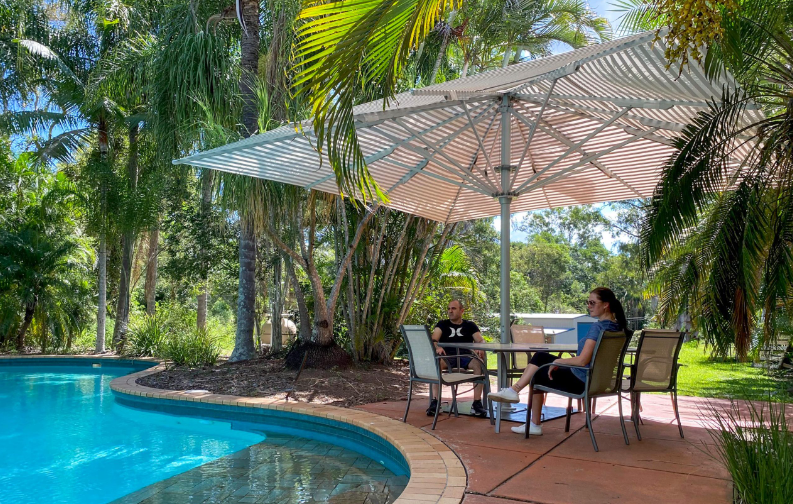An outdoor umbrella has always been a trusted companion to you when you plan a day in the sun on the beach. This is because the umbrella protects you from the harmful rays of the sun. But is the umbrella’s shade enough to protect your skin from burning?
The answer to this is – no.
A recent study published in JAMA Dermatology has shown that 78% of participants had developed a sunburn irrespective of using large outdoor umbrellas. The same study though said that umbrellas are quite effective in protecting you from UV rays as they are designed to filter out 99% of these harmful rays.
In this blog, we tell you what is sunburn, what causes sunburn, and how much protection dark or light-coloured heavy duty outdoor umbrellas give you against the sun. Read on…
What is sunburn?
Sunburn is an inflammatory reaction when UV radiation causes damage to your skin. When the sun’s UV rays touch your skin, your body produces extra melanin — a pigment found in the skin’s outermost layer. Melanin protects your sun-exposed skin from the sun’s rays. For people with less melanin, prolonged exposure to the sun can cause skin cells to become red, swollen and painful, which is otherwise also known as sunburn.
What causes sunburn?
Sunburn happens by scattered or diffused UV rays or reflected light. In fact, this could prove to be tricky as the scattered rays or reflected light can bounce around and come at you from below and sideways. So your umbrella’s shade cannot always protect you from these scattered or reflected rays.
For better understanding, we urge you to ask yourself: Have you set up your outdoor umbrella on a patio? Is your patio made of light-coloured, shiny tiles? Does your umbrella sit on the sand? Is your umbrella part of a table set with chairs where you relax by reading books for hours at a (reflective) glass table? Is your favourite tanning spot next to a pool or fountain?
All these are possible scenarios when the UV rays can come at you from any direction apart from hitting you directly from above. As already mentioned, they can also be reflected from anything light-coloured or shiny. Therefore, reflected or scattered rays can tan you or cause sunburn.
Are dark-coloured or light-coloured umbrellas effective against UV rays?
A research by the Emory School of Medicine found that black heavy duty outdoor umbrellas were best at blocking harmful rays. In fact, they blocked 90 to 95 percent of the UV rays. Under a black umbrella, the amount of radiation touching your skin is the total of the amount of direct light that the fabric allows through plus the amount of reflected light. However, the amount of reflected light is dependent on how the umbrella has been set up. Since it’s difficult to quantify this light, you cannot put a precise number on how much radiation you get.
Umbrellas act like filters between the sun and you. Although it is proven that black umbrellas are one of the best filters, they are still imperfect.
However, we must tell you that black umbrellas are hotter than other large outdoor umbrellas. This is due to the fact that black absorbs more heat and light than white or light colours because they attract more light energy.
Another study suggested that umbrellas generally provide at least 90% protection against UV rays. Among the 23 types of umbrellas that were tested to see the impact of sunlight on them, it was seen that “the poorest performing umbrella still blocked an average of 77% of UV rays. All of the black umbrellas blocked at least 90%, and most blocked more than 95%.”
However, you might not always want to decorate your outdoor space with black umbrellas. So you can always opt for darker shades like navy blue, intense red, emerald green, and vibrant purples. You can also go for vibrant or bright-coloured outdoor umbrellas in Australia but we would suggest you not to choose white and pastel colours. These colours might be good for staying cool but they are not effective when it comes to protecting you from UV rays.
We should also suggest you choose a fabric that has a UV protection factor of more than 50 or higher.
Another crucial factor is the durability of the umbrella. While darker shades could fade quickly and you might need a replacement a lot sooner than you’d expected, light-coloured fabrics are more prone to soiling. So you must select an outdoor umbrella that is made from good quality and solution-dyed material.
ConclusionThe bottom line then is that an outdoor umbrella alone can’t protect your skin from harmful UV rays. However, a multi-pronged approach to sun protection, including shade, sunscreen, protective clothing, and avoiding peak sun hours, could prove to be quite effective.


























